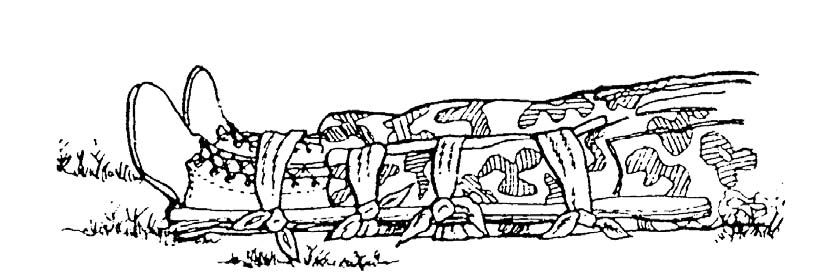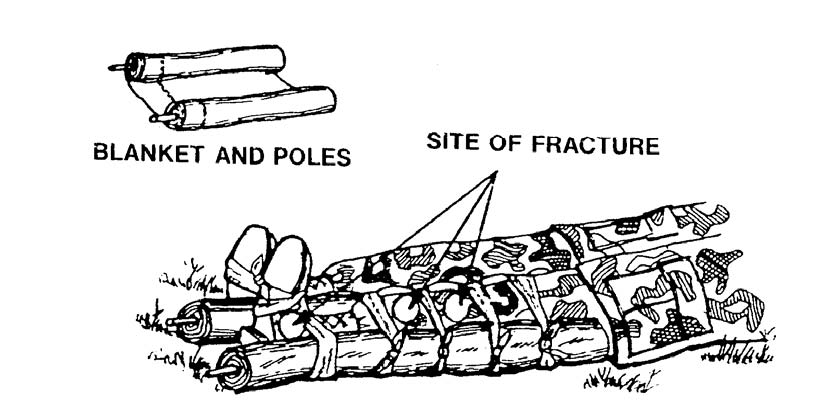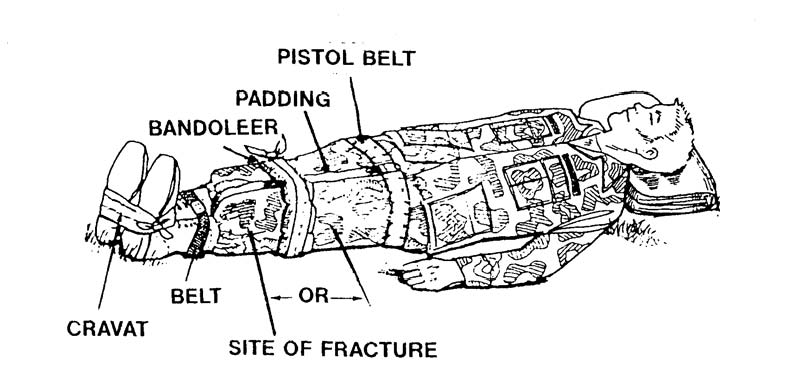Treating Fractures in the Field
Lesson 4: Fractures of the Lower
Extremities
4-4
4-4. IMMOBILIZE A FRACTURED LEG (IMPROVISED SPLINT)
A fractured tibia or fibula in the lower leg can be immobilized with an improvised splint. The improvised splint used to immobilize a fractured thigh (see paragraph 4-3) can also be used to immobilize a fractured leg. The following procedures are used to apply shorter boards to immobilize a fractured leg (see figure 4-5). The same basic procedures can also be used with other improvised splints. Figure 4-6 shows a tree limb splint used to immobilize a fractured leg or ankle. Figure 4-7 shows a blanket and poles splint used to immobilize a fractured knee (knee straight), leg, or ankle. Figure 4-8 shows the casualty's uninjured leg being used as the rigid object (anatomical splint) to immobilize the injured leg. A splint used for a fracture can also be used for a dislocation.
Figure 4-5. Improvised board splint applied to a fractured leg.
Figure 4-6. Improvised tree limb splint applied to a fractured leg.
Figure 4-7. Improvised blanket and poles splint applied to a fractured leg.
Figure 4-8. Uninjured leg used as an anatomical splint.
a. Obtain Materials. You will need two rigid objects, padding, and securing materials. The rigid objects should extend from the casualty's foot to approximately half way up his thigh.
b. Position the Securing Materials. Position two cravats above the fracture site and two below the fracture site. Push the securing materials under natural body curvatures and move them up or down until they are in
proper position. Do not place a cravat directly under the fracture site.
(1) Position one cravat above the knee.
(2) Position the second cravat between the knee and the fracture site.
(3) Position the third cravat between the fracture site and the ankle.
(4) Position the fourth cravat beneath the ankle.
c. Position the Rigid Objects. Place one rigid object on the inside of the injured leg and the other on the outside. Position them so the joint above the fracture and the joint below the fracture can be immobilized.
d. Apply Padding. Place padding between the rigid objects and the limb. Apply extra padding to the knee and ankle areas.
e. Secure the Rigid Objects and Check Circulation. Wrap the securing materials around the rigid objects so they immobilize the limb. Tie the tails of each securing cravat in a non-slip knot on the outer rigid object and away from the casualty. The securing material should be tight enough to hold the rigid objects securely in place, but not tight enough to interfere with blood circulation. (You should be able to slip one finger beneath the knot.) Check the casualty's pulse after each cravat is tied. If the cravat interferes with the casualty's circulation, loosen the cravat and apply it again.
(1) When securing the cravat under the ankle, cup the heel in the cravat, bring the cravat up the outside of the splints, cross the tails over the boot, bring the tails down below the sole of the boot, cross the tails, bring the tails back to the top of the boot, and tie the tails in a non-slip knot at the instep.
(2) If additional support is desired, pass another cravat beneath both ankles and secure the injured leg to the uninjured leg. Bring the cravat up the outside splint and the outside of the uninjured ankle, cross the cravat over the tops of the casualty's boots, bring the tails down below the boots, and tie them together in a non-slip knot at the soles.





